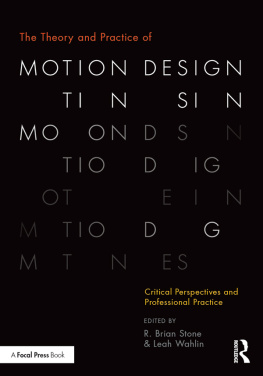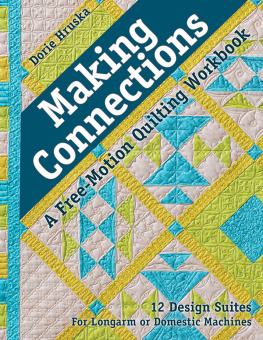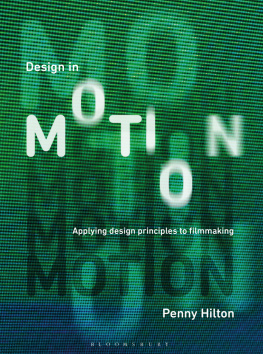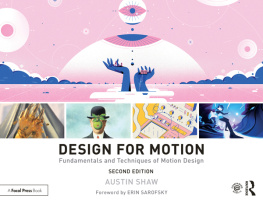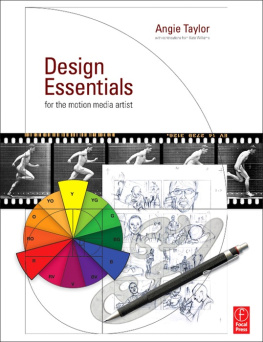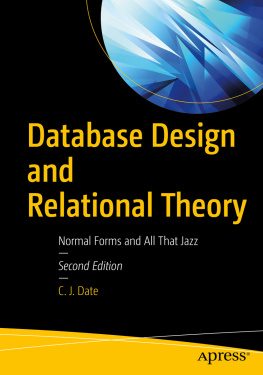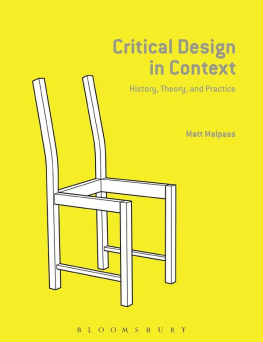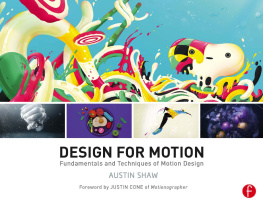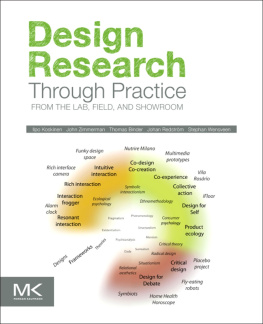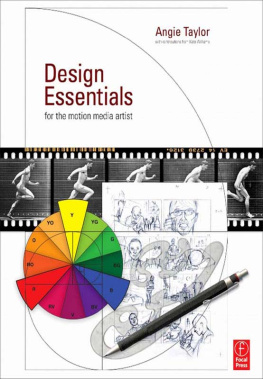
The Theory and Practice of Motion Design
Critical Perspectives and
Professional Practice
The Theory and Practice of Motion Design
Critical Perspectives and
Professional Practice
Edited by
R. Brian Stone & Leah Wahlin

First published 2018
by Routledge
711 Third Avenue, New York, NY 10017
and by Routledge
2 Park Square, Milton Park, Abingdon, Oxon OX14 4RN
Routledge is an imprint of the Taylor & Francis Group, an informa business
2018 Taylor & Francis
The right of R. Brian Stone and Leah Wahlin to be identified as the authors of this work has been asserted by them in accordance with sections 77 and 78 of the Copyright, Designs and Patents Act 1988.
All rights reserved. No part of this book may be reprinted or reproduced or utilised in any form or by any electronic, mechanical, or other means, now known or hereafter invented, including photocopying and recording, or in any information storage or retrieval system, without permission in writing from the publishers.
Trademark notice: Product or corporate names may be trademarks or registered trademarks, and are used only for identification and explanation without intent to infringe.
Library of Congress Cataloging in Publication Data
A catalog record for this book has been requested
ISBN: 978-1-138-49079-6 (hbk)
ISBN: 978-1-138-49080-2 (pbk)
ISBN: 978-1-351-03454-8 (ebk)
Typeset in FF Unit and FF Unit Slab, designed by Erik Spiekermann, Christian Schwartz and Kris Sowersby in 2009.
Edited by R. Brian Stone and Leah Wahlin
Cover design by Meredith Dixon
Interior design by R. Brian Stone
Production by Savannah Storar
Project management by Leah Wahlin
CVLTVRED MIND
SKILLFVL HAND
Author Notes & Acknowledgements
The Department of Design resides in one of the oldest and grandest buildings on the campus of The Ohio State University. An inscription over the doors of Hayes Hall reads, The Cultured Mind The Skillful Hand and serves as a reminder of the human-centered nature of design. It speaks to the pairing of concept and execution at the heart of effective, compelling, and creative communication. It also places into perspective the need for balance. The education of motion designers as well as the practice of motion design require balance. The full potential of the time-based narratives described in this collection is only fully realized by masterful execution.
As editors and collaborators, we have benefited from the balance of our similarities and offsetting differences. We are educators situated in both academia and professional practice in our own careers. Given his grounding in design, Brians voice and experience are explicitly represented in the Introduction and Notes from the Classroom, but Leah has shaped the narrative of those chapters and the project as a whole, approaching the work from her background in technical communication and rhetoric.
The Cultured Mind The Skillful Hand also tells us that design is crafted by people for people. Without the assistance, guidance, critique, and support of so many, this project would not have been made possible. Special thanks go out to Dave Bull, Jessica McManus, Brittany Layton, Kate Noel, Chris Brown, Yuanqing Zhao, Melissa Quintanilha, Chris Myers, and the Cooperistas.
R. Brian Stone
I appreciate the ongoing support of my colleagues in the Department of Design at The Ohio State University with particular acknowledgment to Peter Megert, Paul Nini, Peter Chan, and Liz Sanders. It is important to pay tribute to all my teachers who have given me a solid grounding to live by design. Lastly, thank you to Professor Ken Hiebert, author of Graphic Design Sources, for introducing me to the idea of moving images in the context of design. It has taken hold of me and I hope that my work as a teacher of motion design does justice to your legacy, your willingness to venture into this realm of motion design.
I have had the good fortune of interacting with students from many parts of the world. With each engagement comes an opportunity to learn and grow. Each student has brought to bear a unique aesthetic and perspective on how motion may be used to communicate, entice, or excite. I have learned as much from them as they have from me and I thank you all for your efforts to exceed my expectations at every turn.
In parallel I have worked with some remarkable design professionals. They have been extremely generous in sharing their processes and strategies. Some I have collaborated with and others have simply been mentors.
The field is replete with talent, but educators and practitioners often find themselves working in parallel tracks. The impetus for this book was to intersect those tracksto provide a forum, or, more accurately, a starting point for dialogue between the academia and students that worked across academia and professional practice, intersecting all of these application areas (and the ones we havent even imagined yet) that will define our work in the coming years.
I wish to dedicate this project to my students, who inspire through their curiosity, energy, and diligence, to my friends, as we laugh and grow in the face of all things, good or bad, and my family, for their unconditional love, encouragement, and nurturing. Squatchee
Leah Wahlin
I am always glad to work on a project that allows me to step outside of my own disciplinary boundaries, especially one like this that aims to foster broad, complex critical thinking and conversation in its own right.
Special thanks to Grahamone of the supportive and wonderful people around me who make life better, easier, and more fun. I am grateful for my inter-disciplinary existence in the Department of Engineering Education and my stellar colleagues there. To all our authors and contributorsthank you for your wonderful work and your commitment to this project. If you find yourselves in Columbus, give us a call and well take you out for pancakes.
To connect with us and to see the works discussed in this book in motion, please visit motionresource.com.
Table of Contents
R. Brian Stone
Dan Boyarski
Clarisa E. Carubin
Camila Afanador-Llach
Jennifer Bernstein
Bruno Ribeiro
Michael Betancourt
Spencer Barnes
Elaine Froehlich
David Peacock
Andre Murnieks
Gretchen C. Rinnert, Aoife Mooney, and Marianne Martens
Adam Osgood
Cotter Christian and Catherine Normoyle
Christina Lyons
Steven Hoskins
R. Brian Stone
Heather Shaw
Kyle Cooper
Since the real impact of motion design is in the actual experience of viewing and interaction, we have developed a companion web site to connect you to many of the examples described in the text. www.motionresource.com
R. Brian Stone
Motion Design is both work and play. It is expressive, seductive, and informative. It is akin to the movements of a beautiful dance performance, the gentle patterns of a light rain, or the wispy plume from a candle. It draws its influence from many sources and is an inherently collaborative and transdisciplinary activity. It engages the disciplines of graphic design, animation, cinema, journalism, music, computer science, broadcast media, and mixology. It is an incredibly rich, dynamic, active canvas involving creativity, choreography, and orchestration.
Next page
